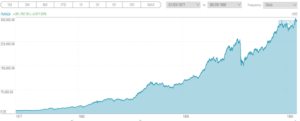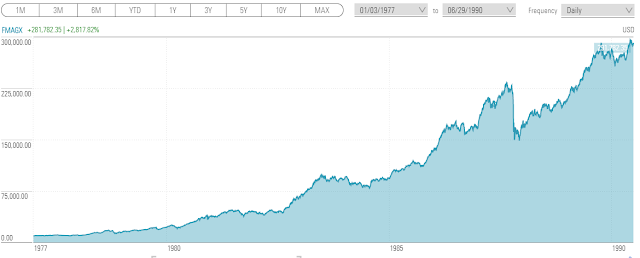
Your portfolio is like a bar of soap…the more you handle it the smaller it gets.
Q2 2020 hedge fund letters, conferences and more
Fidelity Magellan Fund (MUTF:FMAGX) was one of the top performing mutual funds in the US between 1977 and 1990. It was managed by legendary investor Peter Lynch, who popularized the concept of investing in what you know. His fund generated an annualized return of 29% during his tenure at Fidelity Magellan.
Fidelity Magellan vs The S&P 500
This means that a $10,000 investment in the Fidelity Magellan at the beginning of 1977 would have been worth $291,782 by June 30, 1990. The same investment in S&P 500 would have been worth $57,524.
His team had calculated that the annualized average return generated by fund shareholders was only 7% during that time period. This means that a similar $10,000 investment would havebeen worth a little less than $25,000 by June 1990.
This is a very big gap between what the investment would have generated, and the actual returns generated by investors. I would refer to that gap as the behavior gap.
You’d think that having a super-star fund manager would have led investors to stick with him through the inevitable ups and downs, and invest for the long term. Of course, we know that today. But investors were not sure at the time.
Perhaps that’s because his investors were not the buy and hold type. They were chasing what is hot, and then selling at the first setback. When he would have a setback, for example, the money would flow out of the fund through redemptions. Then when he got back on track it would flow back in, having missed the recovery.
Perhaps they listened to economists, or perma-bear doom and gloomers, so they could not hold on to their equity fund. Perhaps they traded too much, because they thought they could buy low and sell high. Unfortunately, as a group, investors ended up buying high, selling low, and compounding their mistakes over several corrections.
Market Timing Does Not Work
This is a bad habit to have when you are investing your hard earned money. Noone knows if a stock is about to go up or down in the short-term, which is why it is pointless to even try. Market timing simply does not work, yet people keep jumping in and out of investments, and ultimately doing much worse than if they simple stayed put. Ultimately, it is time in the market, not timing the market that helps you take full advantage of the long-term power of compounding. That’s how you patiently compound dividend income and capital.
I see the same behavior with some dividend growth investors. Notably, they sell too soon at the first time of trouble.
They also sell too soon if the company works in their favor, but gets a little overvalued. In the long-run, I would expect a successful company to grow earnings, dividends and intrinsic value. The stock price of the business would fluctuate above and below that intrinsic value. Since no one can time the markets well enough to make it worthwhile, it is best to just hop on that train and ride for as long as possible.
If you sell when it is overvalued, you may be making an error. That’s because if the business compounds earnings, dividends and intrinsic value over time, you are missing out on all the future growth by selling.
Trading Too Much Is Hazardous
I read academic research that found how trading too much is hazardous to your wealth.
I have studied my investment activity and the activity of other investors who publicly post their transactions. I have found that when individual investors sell stocks, the companies they replaced them with end up doing much worse than the companies they sold. In other words, thse investors on average ended up taking a perfectly good situation and making it worse.
I have found in my investing that selling has frequently been a mistake. I would have been better off just doing nothing. Hence, selling quality dividend growth stocks over a long investing career will most likely be a mistake.
All of this brings me to the very important point of this article.
As an investor, you need to focus on time in the market, not timing the market.
All you have to do it focus on things within your control, such as your savings rate, the strategy you choose to achieve your goals and your temperament. Nobody can time the market, which is why it is fruitless to even try to do it.
Hence, the goal is to diversify, buy quality over time, and patiently wait for the power of compounding to do the heavy lifting for you. Do not strive for perfection, and do not overtrade. When you trade too much, you increase investment costs in terms of commissions, fees and taxes. But even more importantly, you increase your behavioral costs, and ultimately may suffer a behavior gap. That gap is the difference between the return of an asset that a patient buy and hold investor would have achieved, versus the actual return generated by someone with an itchy finger.
Relevant Articles:
- Time in the market is your greatest ally in investing
- How to improve your investing over time
- Should you sell after yield drops below minimum yield requirement?
- Why would I not sell dividend stocks even after a 1000% gain?
The post The Behavior Gap appeared first on ValueWalk.

